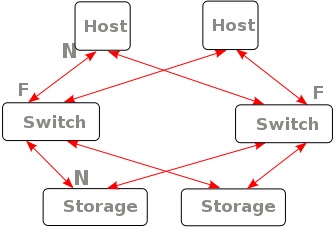What Is Fabric Networking?
By Gail Caros
The term Fabric and Fabric Networking is used a lot these days by almost all vendors,
the question is: What does that actually mean?

Switched Fabric Network
The industry came up with the term "Fabric" to describe networking technologies that
allow networking gear (Switches and L3 Switches) to connect in a way to achieve a mesh topology.
If you think of a real piece of cloth (fabric) the threads create a mesh. Mesh topology has
always been identified as the ideal for resiliency; however, in the past, due to cost and protocol
limitations this has been difficult, if not impossible to achieve.
Traditional networking connectivity had only a few connections between devices. Resiliency
typically meant two trunks, maybe three, especially in the WAN. Recent advancements in technology
now permit intelligent switches to be hyper-connected and thus the term "Fabric" emerged to
describe this new intelligent network. When you hear the term "Fabric" think more than "lots of
links". This new fabric is intelligent and scalable.
What does it mean to have an intelligent network? It means that the devices that comprise
the network fabric are managed and seen as an integrated whole rather than a series of interconnected
devices. The network administrator has the ability to define policies for any device, application,
job classification, individual, etc. These policies can intersect and the fabric will automatically
adjust to provide that object the level of service that the policies dictate. There is no longer
a need to provision each switch and port whenever a new user, device, or application is added
to the organization. An administrator will create the policy, provision the endpoints and the
fabric will auto learn and provision itself to meet the requirements.
This capability is enabled via new technologies and protocols that have been defined
and ratified by the IEEE (Institute of Electrical and Electronics Engineers) and IETF (Internet
Engineering Task Force). To achieve end to end fabric, the network will need to have intelligent
devices capable of SPB (Shortest Path Bridging), and SDN (Software Defined Networks).
TRILL ("Transparent Interconnection of Lots of Links") is another standard that was developed
in an attempt to achieve full fabric networking. While it does meet some of the requirement for
fabric, it is intended only for the core and does not reach to the edge so that the promise
of full fabric and SDN can never be realized.
Gail Caros is a Senior IT Sales Professional currently with Intelli-Flex, Inc., a national leader in
unified communications, video conferencing, voice and data technologies, contact center, network security,
and hosted (cloud) Voice Services. Gail has experience helping customers with selection, design,
implementation and maintenance of large multi-national, multi-vendor IP and VoIP Contact Centers and
the networks that support them.
More Networking Protocols and Standards:
• Session Border Controllers - More Than Just a Voice Firewall
• Ports and Sockets
• IPv6 Global Unicast Addresses
• A Simple Description of the IPv6 Header and Datagram
• IPv6 Address Format
• How to Set Up FTP (File Transfer Protocol)
• TCP/IP Protocol Suite
• TCP Windowing
• Video - Introducing the OSI Model
• The OSI Data Link Layer
| 
